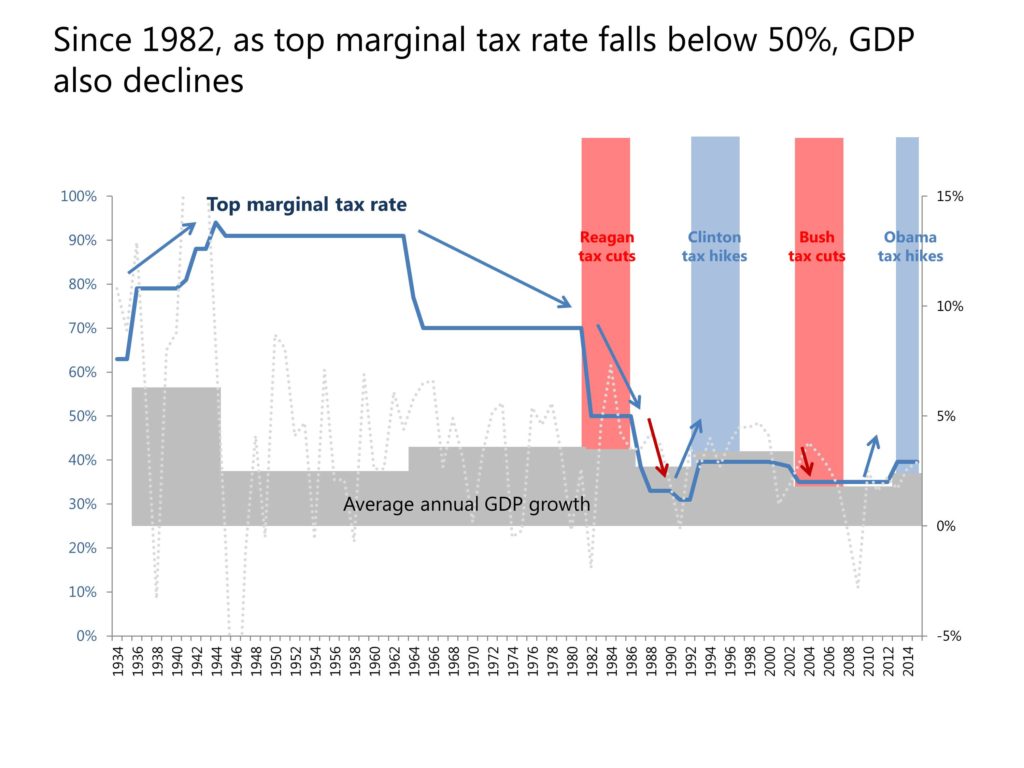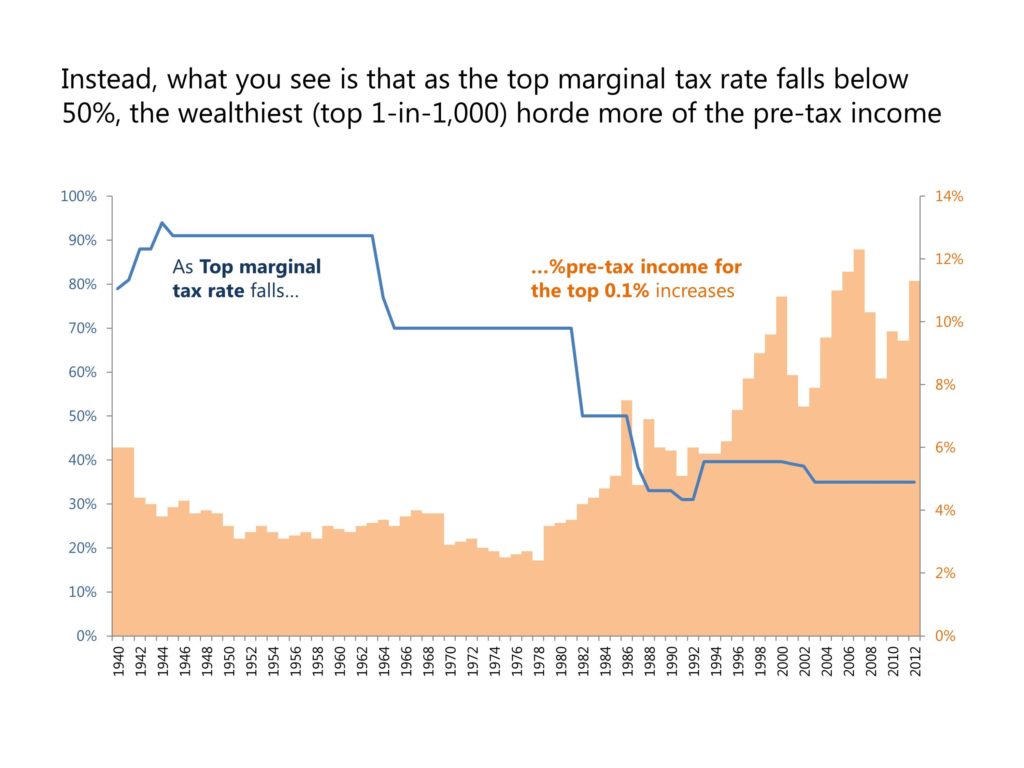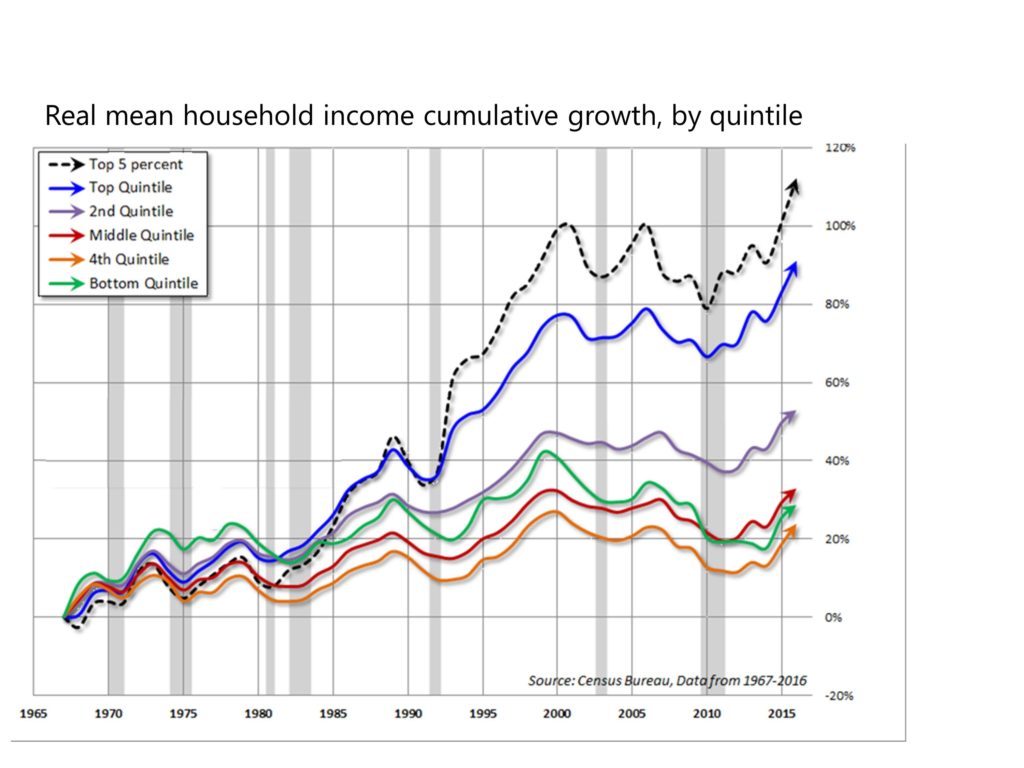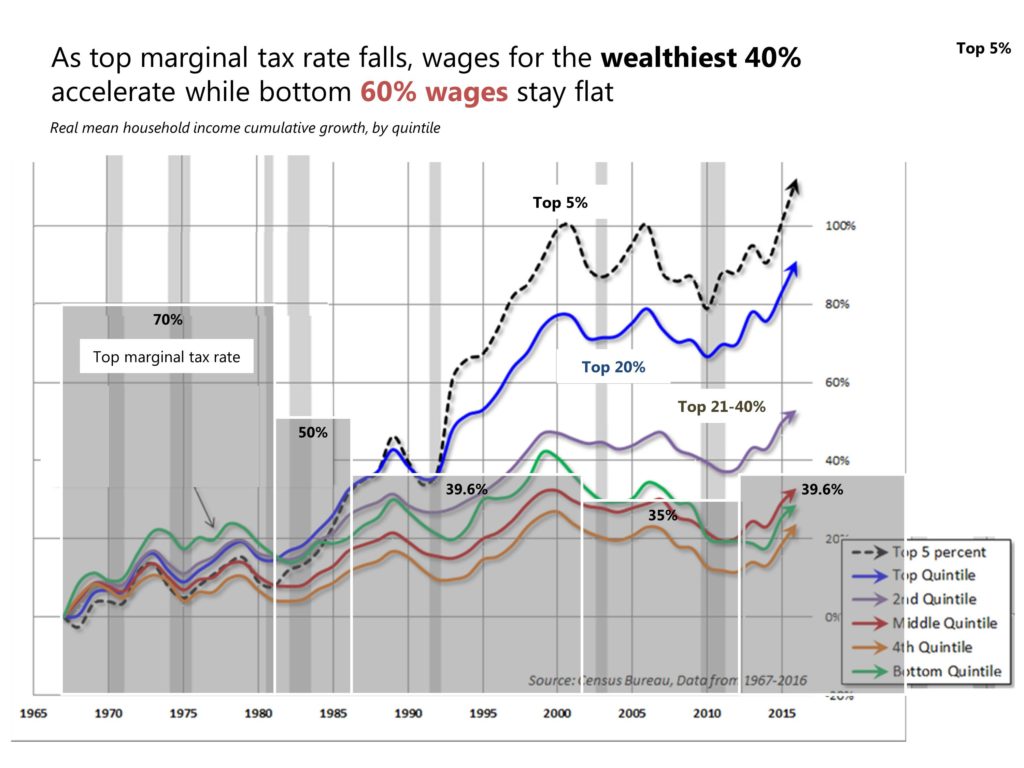Storytelling with a Stacked Bar Chart
November 29, 201710 Rules for Graph Annotations
January 24, 2018The GOP is promising their massive tax cuts will spur economic growth and increase wages. This is the “trickle-down economics” theory, based on the idea that when wealthy people have more money, they invest in companies that can now expand, hire more people and increase sales and wages.
It’s an interesting theory. But does trickle-down economics actually work in practice? Fortunately we have nearly 100 years of data on what happens to the economy and wages as tax rates change.
// Does the economy grow?
Since 1929, the top marginal tax rate has gone from a high of 94% under Roosevelt down to a low of 31% under George Bush Sr. And there is evidence that as you drop the marginal rate to 70% from 91%, indeed GDP does increase (1963-1981). But when Reagan cut the top marginal tax rate to 50% in 1981, we saw no change in economic growth. When he cut it again to 33% in 1988, the economy actually contracted.
 Since Reagan’s tax cuts, we have seen three other changes to the top marginal tax rate. And a clear pattern emerges.
Since Reagan’s tax cuts, we have seen three other changes to the top marginal tax rate. And a clear pattern emerges.
- When Clinton raised the top rate to 39.6%, GDP increased.
- When Bush Jr. dropped it again to 35%, GDP decreased.
- When Obama raised it back to its current 39.6%, GDP increased.
Based on this brief analysis, it appears the optimal top marginal tax rate is about 50%. When you drop below 50%, you hurt economic growth. When you increase it, you improve economic growth. So it’s likely that a drop to 37% top marginal tax rate will lead to slower economic growth, not faster.
// Will it increases wages?
The theory is that when wealthier people have more money, they expand their business investments creating jobs and demand for workers, which raises wages. But when we look at how wages have grown since 1967, we see a different patterns. When the top tax rate was 70%, the top 20% of families had wage growth about the same as everyone else.
But look at 1982, when the top tax bracket fell to 50%. You can see how the blue line (wealthiest 20%) suddenly rockets away from the crowd. Wages for everyone are still increasing modestly, but the clear winner is the top 20%. Then in 1988, when the top bracket drops to 33%, we see the top 20% pull away even more, and especially the top 5% (black dotted line). In 2003, when the top tax rate drops to 35%, we now see the top 21%-40% of families (brown line) also start to pull away from the pack.
What you don’t see is the bottom 60% enjoying any of these gains. Why is the wealth not trickling down to everyone? Because when employers have more money, they don’t hand it out as pay raises out of the goodness of their hearts. They pay what the market will bear and keep the rest for their stockholders and owners.
// So what does trickle-down economics do?
So lower taxes don’t create jobs and don’t increase wages. What do they do?
The main thing lower tax rates do is make the wealthy more wealthy. Fortunately it doesn’t really hurt the bottom 60%. Their wages continue to increase modestly. And it does appear to help the middle class too, likely educated business professionals who now have more money to spend. But the truly wealthy, the top 20%, just accumulate more wealth.
We can see in this graph how much of the pre-tax income goes to the top 0.1% (that’s the top 1 in 1,000 families). The spikes are because so much of their income comes from the stock market, so when things are bad (2002, 2009) their pre-tax income suffers. But it recovers quickly when the stock market improves.
 As the top marginal tax rate declines, the extra money gets trapped in the hands of the wealthy. They, in turn, invest in the stock market. We should expect to see the stock market explode if the GOP tax plan is approved. Again, anything below a 50% top marginal tax rate appears to be a magic number.
As the top marginal tax rate declines, the extra money gets trapped in the hands of the wealthy. They, in turn, invest in the stock market. We should expect to see the stock market explode if the GOP tax plan is approved. Again, anything below a 50% top marginal tax rate appears to be a magic number.
// Conclusion
There’s no evidence lowering taxes increases the economy or wages. There is a lot of evidence that it makes the wealthy wealthier while doing very little for the poor. Trickle-down economics is a fairy tale.
So will the new tax rate be good for you? If you’re in the top 40% of income earners, you will probably see your wages increase especially if you invest in the stock market which should have a bullish couple of years ahead.
But if you’re in the lower 60%, it will have virtually no effect. It won’t create jobs but it likely won’t kill many jobs either. And it won’t raise wages either.
The main benefits fall to the wealthy. The data is clear.
If you like these graphs, you’ll love my new book “Storytelling with Graphs” which I hope to publish soon. Subscribe to this blog to be alerted when it’s available.




1 Comment
Awesome – love that you “go there.”